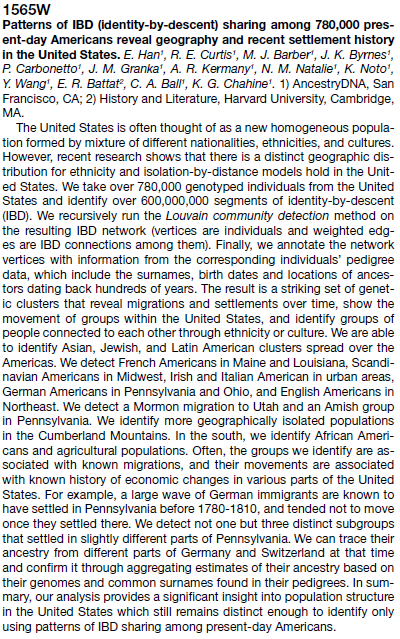razib tweeted earlier this week:
Granka et al. #ashg2015 ancestry dna is using huge 500K data set in USA. looks like they may confirm or refute #AlbionsSeed models
— Razib Khan (@razibkhan) September 13, 2015
granka is julie granka who already did some preliminary blogging about these findings last year over at ancestry.com. #ashg2015 is this year’s american society of human genetics annual meeting which is being held next month. here is granka et al.’s poster abstract from that meeting:
so they’ve been able to detect three subgroups of germans in pennsylvania and can connect those subgroups to their populations of origin back in germany or switzerland. cool! i really, really, really hope they’ve been able to do the same for the various subgroups that came from britain, a la Albion’s Seed!
mr. random c. analysis, esq., did some blogging on these data last year, too. and, of course, jayman has been all over american nations issues for the past couple of years (see here and here, for example).
i’m trying to ease myself gently back into blogging, so for now i’ll just leave you with my tweets of some of granka’s american nations’ genetics maps from ancestry.com:
_____
previously: the american revolutions
(note: comments do not require an email. albion.)

[…] By hbd chick […]
In a perfect world some precautions would be taken so that the researchers, or some of them, have to behave as if it were a double-blinded experiment, otherwise it might be too tempting to see in the data patterns that they already know ought to exist.
A question: how were the 780,000 selected? That too ought surely to be treated as an exercise in experimental design, with randomisation at some agreed level of scrutiny.
Readers of course see also:
More Maps of the American Nations
Demography is Destiny, American Nations Edition
The latter one uses longitudinal Census data to track the actual ancestry components across the country, which agrees with (and is finer-grained than) the genetic models.
As for confirming/refuting the whole Albion’s Seed model, they need to be able to distinguish between the “Four British Folkways” in the genetic data to do that. As per:
Genes, Climate, and Even More Maps of the American Nations
…we know that those British traditions are visible in modern genetic data from Britain, so it is quite likely possible. I’d just like to see if they actually did it.
And of course we know that the ancestry.com/23andMe people aren’t exactly representative of the population (not for the least reason that genetic testing costs $$$).
yes german people
[…] Source: HBD Chick […]
@dearieme – “A question: how were the 780,000 selected? That too ought surely to be treated as an exercise in experimental design, with randomisation at some agreed level of scrutiny.”
@jayman – “And of course we know that the ancestry.com/23andMe people aren’t exactly representative of the population (not for the least reason that genetic testing costs $$$).”
yeah. sampling is the big problem here, and, for the reasons jayman stated, these data are not a truly representative sample, alas alack.
still – it’s a start! imho, i think nearly all of today’s genetics research should be viewed as part of an ongoing investigation in which there will be twists and turns — and maybe even radical new directions — as new evidence is uncovered. but we (i mean, teh scientists) have to start somewhere!
(btw – same holds true for this blog. nearly everything i have to say ought to be viewed as part of a work in progress — and largely speculative — and *not* the final word on anything.)
[…] errors. On the way to the jury box? The case for leftist over-reach on race (plus commentary). Genetics of the American nations. Weird […]
fun stuff
[…] was pretty interesting over at HBD Chick’s: the genetics of the american nations. Dig them graphics. And moar of ’em with spain’s north-south […]